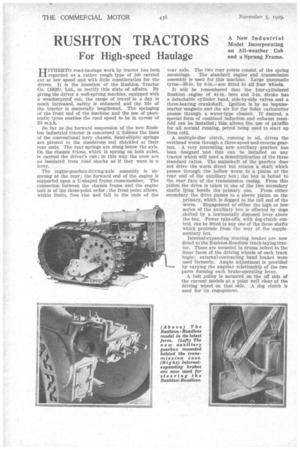RUSHTON TRACTORS
Page 156

If you've noticed an error in this article please click here to report it so we can fix it.
For High-speed Haulage
A New Industrial Model Incorporating an All-weather Cab and a Sprung Frame, HITHERTO road-haulage work by tractor has been .1J-regarded as a rather rough type of job carried out at low speed and with little consideration for the driver. It is the intention of the Rushton Tractor Co. (1929), Ltd., to rectify this state of affairs. By giving the driver a well-sprung machine, equipped with a weatherproof cab, the range of travel in a day is much increased, safety is enhanced and the life of the tractor is materially lengthened. The springing of the front end of the machine and the use of pneumatic tyres enables the road speed to be in excess of 20 m.p.h.
So far as the forward suspension of the new Rushton industrial tractor is concerned it follows the lines of the conventional lorry chassis. Semi-elliptic springs are pivoted to the dutnbirons and shackled at their rear ends. The tear springs are slung below the axle. On the chassis frame, which is sprung on both axles, is carried the driver's cab; in this way the crew are as insulated from road shocks as if they were in a lorry.
The engine-gearbox-driving-axle assembly is unsprung at the rear ; the forward end of the engine is supported upon a U-shaped frame cross-member. The connection between the chassis frame and the engine unit is of the three-point order ; the front point allows, within limits, free rise and fall to the ends of the rear axle. The two rear points consist of the spring mountings. The standard engine and transmission assembly is used for this machine. Large pneumatic tyres--,36-in. by 0-in.---are fitted to all four wheels.
It will be remembered that the four-cylindered Rushton engine of bore and 5-in, stroke has a detachable cylinder head, side-by-side valves and a three-bearing crankshaft. Ignition is by an impulsestarter magneto and the air for the Solex carburetter passes through a water-type cleaner. If desired, a special form of combined induction and exhaust manifold can be installed; this allows the use of paraffin for all normal running, petrol being used to start up from cold.
A multiple-disc clutch, running in oil, drives the overhead worm through a three-speed-and-reverse gearbox. A very interesting new auxiliary gearbox has been designed and this can be installed on any tractor which will need a demultiplication of the three standard ratios. The mainshaft of the gearbox does not drive the worm direct but rotates a shaft which passes through the hollow worm to a pinion at the rear end of the auxiliary box; the box is bolted to the rear face of the transmission casing. From this pinion the drive is taken to one of the two secondary
shafts lying beside the primary one. From either secondary the drive passes to a sleeve pinion on the primary, which is dogged to the tail end of the worm. Engagement of either the high or low series of the auxiliary box is effected by dogs shifted by a horizontally disposed lever above the box, Power take-offs, with dog-clutch control, can be fitted to any one of the three shafts which protrude from the rear of the supplementary box.
Internal-expanding steering brakes are now fitted to the Rushton-Roadless track-laying tractor. These are mounted in drums bolted to the inner faces of the driving wheels of each track bogie; external-contracting band brakes were used formerly. Ample adjustment is provided by varying the angular relationship of the two parts forming each brake-operating lever.
A belt pulley is mounted on the off side of the current models at a point well clear of the driving wheel on that side. A dog clutch is used for its engagement.




































































































































































































































































